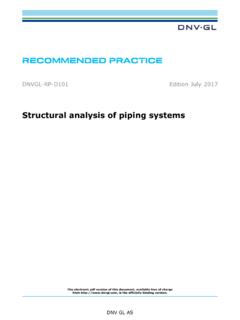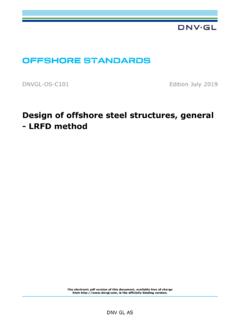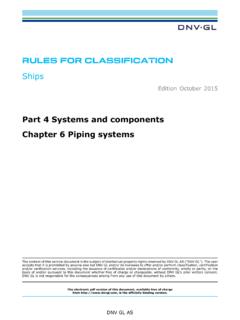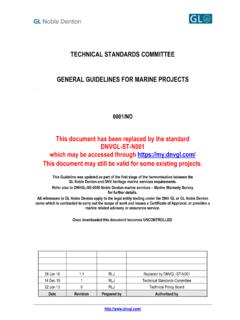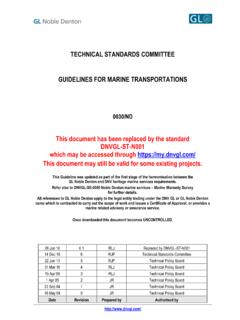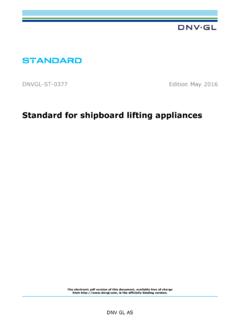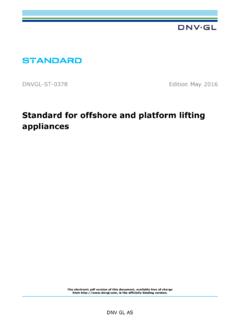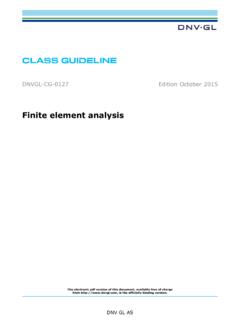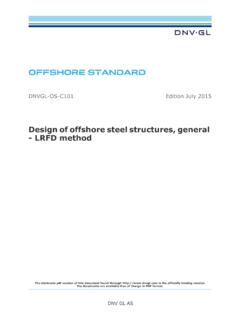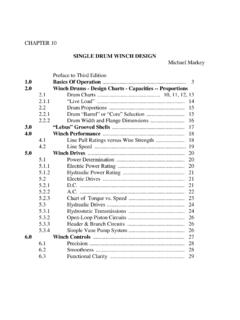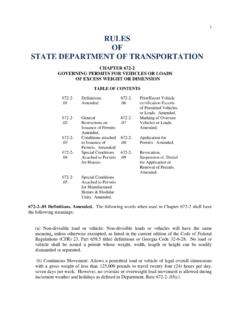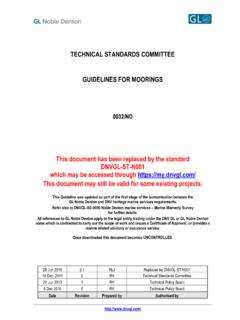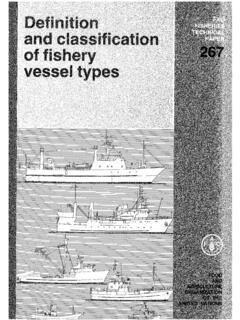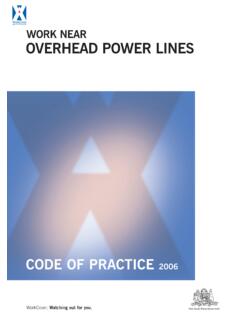Transcription of DNVGL-RU-SHIP Pt.3 Ch.11 Hull equipment, supporting ...
1 The content of this service document is the subject of intellectual property rights reserved by DNV GL AS ("DNV GL"). The useraccepts that it is prohibited by anyone else but DNV GL and/or its licensees to offer and/or perform classification, certificationand/or verification services, including the issuance of certificates and/or declarations of conformity, wholly or partly, on thebasis of and/or pursuant to this document whether free of charge or chargeable, without DNV GL's prior written GL is not responsible for the consequences arising from any use of this document by electronic pdf version of this document, available free of chargefrom.
2 Is the officially binding GL ASRULES FOR CLASSIFICATIONS hipsEdition January 2017 Part 3 HullChapter 11 Hull equipment, supportingstructure and appendagesFOREWORDDNV GL rules for classification contain procedural and technical requirements related to obtainingand retaining a class certificate. The rules represent all requirements adopted by the Society asbasis for classification. DNV GL AS January 2017 Any comments may be sent by e-mail to any person suffers loss or damage which is proved to have been caused by any negligent act or omission of DNV GL, then DNV GL shallpay compensation to such person for his proved direct loss or damage.
3 However, the compensation shall not exceed an amount equal to tentimes the fee charged for the service in question, provided that the maximum compensation shall never exceed USD 2 this provision "DNV GL" shall mean DNV GL AS, its direct and indirect owners as well as all its affiliates, subsidiaries, directors, officers,employees, agents and any other acting on behalf of DNV 3 Chapter 11 Changes - currentRules for classification: Ships DNVGL-RU-SHIP Edition January 2017 Page 3 Hull equipment, supporting structure and appendagesDNV GL ASCHANGES CURRENTThis document supersedes the July 2016 in this document are highlighted in red colour.
4 However, if the changes involve a whole chapter,section or sub-section, normally only the title will be in red changes January 2017, entering into force as from date ofpublication Anchoring and mooring equipment [ ]: Projected area calculation for EN of mooring. A difference from IACS had been noted and isnow corrected Table 10: Calculation of continuous duty pull. The requirement is aligned with IACS. supporting structure for deck equipment and fittings [ ]: The difference between requirement to offshore cranes and other cranes is clarified.
5 Bulwark and protection of crew [ ]: The reference to every frame is not found appropriate for bulwark in the bow area. Thetext is deleted and replaced with a reference to the bow impact requirements for correctionsIn addition to the above stated changes, editorial corrections may have been 3 Chapter 11 ContentsRules for classification: Ships DNVGL-RU-SHIP Edition January 2017 Page 4 Hull equipment, supporting structure and appendagesDNV GL ASCONTENTSC hanges 1 Anchoring and mooring Documents and certificates to be Structural arrangement for anchoring 73 Equipment Equipment Equipment Anchor Additional requirements for and 195 Anchor chain General Materials and Heat Proof load Breaking load Mechanical Inspection and dimensional 316 Windlass and chain General Towlines and mooring 3 Chapter 11 ContentsRules for classification.
6 Ships DNVGL-RU-SHIP Edition January 2017 Page 5 Hull equipment, supporting structure and appendagesDNV GL Testing of steel wire Testing of natural fibre Mooring 2 supporting structure for deck equipment and Documents to be Anchoring windlass and chain Design loads for anchoring Design loads for fore deck windlass against green Acceptance Heavy equipment, winches others than those used for mooring andtowing and other pulling Design Acceptance Cranes, A-frames, derricks, lifting masts and life Application and Structural Design Acceptance Shipboard fittings and supporting hull structures associated withtowing and Introduction and Shipboard supporting hull Design Acceptance Safe working load (SWL).
7 536 Miscellaneous deck Support and 3 Chapter 11 ContentsRules for classification: Ships DNVGL-RU-SHIP Edition January 2017 Page 6 Hull equipment, supporting structure and appendagesDNV GL ASSection 3 Bulwark and protection of General Minimum Construction of 543 Protection of the Guard Gangways, walkways and 57 Section 4 Documents to be Bilge Material, design and structural 613 Propeller Nozzle ring Propeller shaft Elastic stern Strength 3 Chapter 11 Section 1 Rules for classification.
8 Ships DNVGL-RU-SHIP Edition January 2017 Page 7 Hull equipment, supporting structure and appendagesDNV GL ASSECTION 1 ANCHORING AND MOORING EQUIPMENTS ymbolsFor symbols not defined in this section, see The requirements given in this section apply to equipment and installation for anchoring and Towlines and mooring lines are not subject to classification. Lengths and breaking strength are,however, given in the equipment tables as guidance. If voluntary certification of such equipment isrequested, it shall be carried out in accordance with [7].
9 Documents and certificates to be submittedThe documents and certificates to be submitted are specified in The anchoring equipment required is the minimum considered necessary for temporary mooring of avessel in moderate sea conditions when the vessel is awaiting berth, tide, etc. The equipment is thereforenot designed to hold a vessel off fully exposed coasts in rough weather or for frequent anchoring operationsin open sea. In such conditions the loads on the anchoring equipment will increase to such a degree that itscomponents may be damaged or lost owing to the high energy forces note:If the intended service of the vessel is such that frequent anchoring in open sea is expected, it is advised that the size of anchorsand chains is increased above the rule requirements, taking into account the dynamic forces imposed by the vessel moving inheavy seas.
10 The equipment numeral (EN) formula for required anchoring equipment is based on an assumed current speed of , wind speed of 25 m/s and a scope of chain cable between 6 and 10, the scope being the ratio between length of chain paidout and water The anchoring equipment required by the rules is designed to hold a vessel in good holding ground inconditions such as to avoid dragging of the anchor. In poor holding ground the holding power of the anchorswill be significantly It is assumed that under normal circumstances the vessel will use only one bower anchor and chaincable at a Structural arrangement for anchoring The anchors shall normally be housed in hawse pipes of suitable size and form to prevent movement ofanchor and chain due to wave arrangements shall provide an easy lead of the chain cable from the windlass to the anchors.
